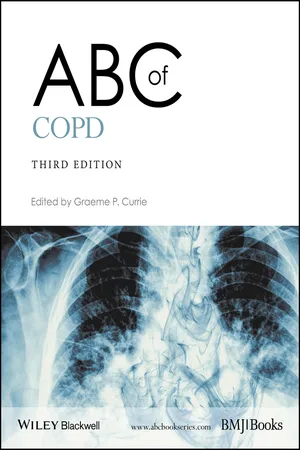ABC of COPD
About this book
The third edition of the ABC of COPD provides the entire multidisciplinary team across both primary and secondary care with an up-to-date, easy to read and accessible account of this common lung disorder. Thoroughly updated by experienced clinicians dealing with patients with COPD on a regular basis, it discusses the entire breadth of the condition from epidemiology, causes, diagnosis, treatment and end of life care.
This practical and highly visual guide contains new and extensively updated chapters on diagnosis, smoking cessation and interventional approaches as well as expanded content on non-pharmacological and pharmacological management taking into account the most recent national and international guidelines. It also explores practical issues relating to COPD in terms of pulmonary rehabilitation, oxygen use, air travel, and end of life care.
The ABC of COPD is an authoritative and essential guide for specialist nurses, general practitioners, physiotherapists, junior doctors, front line staff working in emergency departments, paramedics, physician associates and students of medicine and its allied disciplines.
Frequently asked questions
- Essential is ideal for learners and professionals who enjoy exploring a wide range of subjects. Access the Essential Library with 800,000+ trusted titles and best-sellers across business, personal growth, and the humanities. Includes unlimited reading time and Standard Read Aloud voice.
- Complete: Perfect for advanced learners and researchers needing full, unrestricted access. Unlock 1.4M+ books across hundreds of subjects, including academic and specialized titles. The Complete Plan also includes advanced features like Premium Read Aloud and Research Assistant.
Please note we cannot support devices running on iOS 13 and Android 7 or earlier. Learn more about using the app.
Information
CHAPTER 1
Definition, Epidemiology and Risk Factors
OVERVIEW
- Chronic obstructive pulmonary disease (COPD) is defined by relatively fixed airflow obstruction.
- The number of individuals diagnosed with COPD is far less than the actual number thought to be affected. Prevalence increases with age and socioeconomic deprivation.
- Globally, COPD is projected to be the third leading cause of death by 2030 with the majority of deaths likely to be in low‐/middle‐income countries.
- The impact of COPD, particularly exacerbations, on health service resource is considerable.
- Risk factors for COPD include cigarette smoking, indoor air pollution (particularly close and regular exposure to combustion of biomass fuels), outdoor air pollution, occupational exposure to some dusts, vapours, irritants and fumes and α1‐antitrypsin deficiency.
Definition
Box 1.1 Definitions of conditions associated with airflow obstruction.
- COPD is a common preventable and treatable disease characterised by persistent airflow limitation that is usually progressive and associated with an enhanced chronic inflammatory response in the airways and the lung to noxious particles or gases. Exacerbations and co‐morbidities contribute to the overall severity in individual patients.
- Chronic bronchitis is defined as the presence of chronic productive cough on most days for 3 months, in each of 2 consecutive years, in a patient whom other causes of productive cough have been excluded.
- Emphysema is defined as abnormal, permanent enlargement of the distal airspaces, distal to the terminal bronchioles, accompanied by destruction of their walls and without obvious fibrosis.
- Asthma is characterised by widespread narrowing of the bronchial airways which changes in severity over short periods of time, either spontaneously or following treatment.
Epidemiology
Prevalence



Table of contents
- Cover
- Title Page
- Table of Contents
- Contributors
- Foreword
- CHAPTER 1: Definition, Epidemiology and Risk Factors
- CHAPTER 2: Pathology and Pathogenesis
- CHAPTER 3: Diagnosis
- CHAPTER 4: Spirometry
- CHAPTER 5: Smoking Cessation
- CHAPTER 6: Non‐pharmacological Management
- CHAPTER 7: Pharmacological Management I –Inhaled Treatment
- CHAPTER 8: Pharmacological Management II – Oral Treatment
- CHAPTER 9: Drug Delivery Devices
- CHAPTER 10: Surgical and Interventional Strategies
- CHAPTER 11: Oxygen
- CHAPTER 12: Exacerbations
- CHAPTER 13: Ventilatory Support
- CHAPTER 14: Primary Care
- CHAPTER 15: Death, Dying and End‐of‐Life Issues
- CHAPTER 16: Future Treatments
- Index
- End User License Agreement
